常见自然灾害英文单词
- 格式:docx
- 大小:27.85 KB
- 文档页数:11

译林版牛津初中英语八年级上册Unit8Natural disasters知识点归纳及巩固练习题1. disaster n. 灾难;不幸,祸患natural disasters 自然灾害2. mop vt. 用拖把擦干净(mopped mopping)up adv 完全地mop up / eat up /clean up /use upmop up 拖干,把......拖干(mop it /them up)eg. Hobo wants Eddie to mop up all the water. earthquake n. 地震an earthquake in the earthquake eg. There was an earthquake in Sichuan in 2008.4. 1)thousands of 成千上万的/hundreds of 成百上千的/ millions of 成百万的+名词复数eg. Thousands of people lost their lives in the earthquake.There are thousands of people on the road.2)数词+hundred/thousand/million+名词复数There are three thousand students in our school.5. accident n. 事故,意外的事eg. There was a car accident yesterday.昨天有一场交通事故。
A car accident killed three men three days ago.Three men lost their lives in the car accident three days ago. 在三天前的一场交通事故中三人丧生。
6. coach n. 长途汽车(coaches) get on/off the coachIt took us three hours to go to Nanjing by coach. .7. crash vi. & vt. 猛撞;碰撞crash into 猛撞,碰撞eg. A car crashed into a tree last night. 昨天晚上一辆车猛撞到一棵树上。

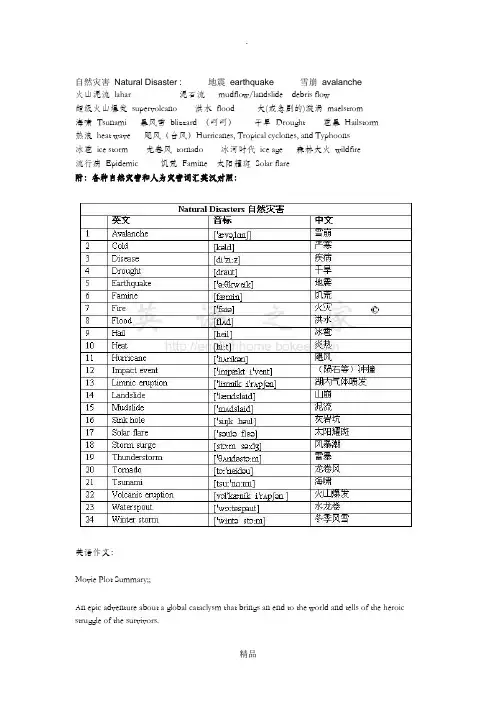
自然灾害Natural Disaster : 地震earthquake 雪崩avalanche火山泥流lahar 泥石流mudflow/landslide debris flow超级火山爆发supervolcano 洪水flood 大(或急剧的)漩涡maelstrom海啸Tsunami 暴风雪blizzard (呵呵)干旱Drought 雹暴Hailstorm热浪heat wave 飓风(台风)Hurricanes, Tropical cyclones, and Typhoons冰雹ice storm 龙卷风tornado 冰河时代ice age 森林大火wildfire流行病Epidemic 饥荒Famine 太阳耀斑Solar flare附:各种自然灾害和人为灾害词汇英汉对照:英语作文:Movie Plot Summary;;An epic adventure about a global cataclysm that brings an end to the world and tells of the heroic struggle of the survivors.An academic researcher leads a group of people in a fight to counteract the apocalyptic events that were predicted by the ancient Mayan calendar and other historical documents, astronomy, biblical and scientific data. It involves the passage of the Age of Pieces into the Age of Aquarius. It also involves the Destroyer, aka Wormwood, Planet X, Nibiru.Over the decades, many have prophesised that the world will end when the ancient Mayan calendar ceases on 21 December 2012. But before that occurs, the human race is bound to face natural disasters such as massive volcano eruptions, typhoons and other natural calamities. An academic researcher opens a portal into a parallel universe and makes contact with his double in order to prevent an apocalypse predicted by the ancient Mayans.Watch online Movie Trailer free 2012 Hollywood film.The film Directed by Roland Emmerich.The Story : 2012 movie tells the story of natural disasters foretold by ancient calendar angle. Sun storms are affecting Earth, culminating in tsunamis, earthquakes and volcanoes. The story itself appears to be standard for disaster movies - short on science, long on stories of numerous individuals, and high on amazing special effects, with a small dose of conspiracy. It’s highly likely a pet dog survives…电影情节摘要;;一个关于全球性灾难,这带来了对世界的结束和对幸存者的可歌可泣的英勇斗争,告诉冒险。
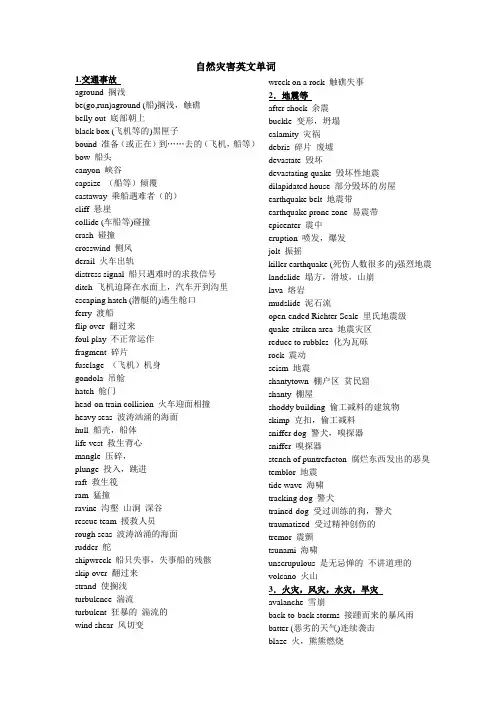
自然灾害英文单词1.交通事故aground 搁浅be(go,run)aground (船)搁浅,触礁belly out 底部朝上black box (飞机等的)黑匣子bound 准备(或正在)到……去的(飞机,船等)bow 船头canyon 峡谷capsize (船等)倾覆castaway 乘船遇难者(的)cliff 悬崖collide (车船等)碰撞crash 碰撞crosswind 侧风derail 火车出轨distress signal 船只遇难时的求救信号ditch 飞机迫降在水面上,汽车开到沟里escaping hatch (潜艇的)逃生舱口ferry 渡船flip over 翻过来foul play 不正常运作fragment 碎片fuselage (飞机)机身gondola 吊舱hatch 舱门head-on train collision 火车迎面相撞heavy seas 波涛汹涌的海面hull 船壳,船体life vest 救生背心mangle 压碎,plunge 投入,跳进raft 救生筏ram 猛撞ravine 沟壑山涧深谷rescue team 援救人员rough seas 波涛汹涌的海面rudder 舵shipwreck 船只失事,失事船的残骸skip over 翻过来strand 使搁浅turbulence 湍流turbulent 狂暴的湍流的wind shear 风切变wreck on a rock 触礁失事2.地震等after shock 余震buckle 变形,坍塌calamity 灾祸debris 碎片废墟devastate 毁坏devastating quake 毁坏性地震dilapidated house 部分毁坏的房屋earthquake belt 地震带earthquake prone zone 易震带epicenter 震中eruption 喷发,爆发jolt 振摇killer earthquake (死伤人数很多的)强烈地震landslide 塌方,滑坡,山崩lava 熔岩mudslide 泥石流open-ended Richter Scale 里氏地震级quake-striken area 地震灾区reduce to rubbles 化为瓦砾rock 震动seism 地震shantytown 棚户区贫民窟shanty 棚屋shoddy building 偷工减料的建筑物skimp 克扣,偷工减料sniffer dog 警犬,嗅探器sniffer 嗅探器stench of puntrefacton 腐烂东西发出的恶臭temblor 地震tide wave 海啸tracking dog 警犬trained-dog 受过训练的狗,警犬traumatized 受过精神创伤的tremor 震颤tsunami 海啸unscrupulous 是无忌惮的不讲道理的volcano 火山3.火灾,风灾,水灾,旱灾avalanche 雪崩back-to-back storms 接踵而来的暴风雨batter (恶劣的天气)连续袭击blaze 火,熊熊燃烧blizzard 暴风雪carcase(carcass) (动物的)尸体,(蔑)人的尸体cataclysm 洪水char 烧焦choppy 风向不定的,波浪涛涛的collapse 倒坍crest 洪峰cyclone 气旋,旋风dam 水坝deluge 洪水depression 低气压dismal 凄凉的driving rain 倾盆大雨drizzle 牛毛细雨drought 干旱drown 淹死dump (雨水)倾泻embankment 堤岸embank 筑堤防护engulf 席卷吞噬flame 火焰flood-ravaged area (洪水)受灾区fume (浓烈或难闻的)烟,气,汽gale 狂风gust 阵风,(风雨雹)突然一阵gut 损毁(房屋等)内部装置hurricane 飓风inundate 水淹jetty 防波堤knee-deep (积雪等)齐膝深的,没膝的levee 大堤low-lying 地势低洼的maroon (杯水围困)处于孤立无援的境地monsoon 季风monsoon rain (印度洋)季雨pelt 连续打击,(雨雪)大降pound (连续)猛击pour 下倾盆大雨rainfall 降雨量(typhoon-)ravaged area 被(台风)破坏的地区scorch 烧焦sift 筛选详查silt 淤泥,使淤塞sleet 雨夹雪smoulder 焖烧spell (某种天气的)一段持续时间squall (冰雹)暴风stampede 惊跑乱窜stifle 使窒息submergence 浸没,淹没subside (洪水)减退suffocate 使窒息sweep (风等)刮起,浪等冲走terrified 恐惧的tornado 龙卷风torrential rain 骤雨trample 踩twister 陆海卷风,沙柱尘旋typhoon 台风uproot 连根拔wash away 冲走water-logged 涝的4. 其他用语(flood)-struck area (洪水)受灾区aid worker 救援人员make-shift 临时凑用的代用品makeshift house 临时住房philanthropic 慈善的philanthropist 慈善家philanthropoid 慈善基金会经纪人philanthropy 慈善事业puddle 水坑race against the clock 争分夺秒rage (风)狂吹,浪汹涌,病猖獗ready-made 现成的,预制的rescue worker 救援人员小雨light rain 阵雨shower 平静calm毛毛雨drizzle,fine rain 疾风gusty wind 微波rippled反常天气freakish weather 气旋cyclone 微浪smooth wavelets北风north wind 气压barometric pressure细浪light seas冰ice 阴天cloudy day 小浪moderate seas冰点freezing point 雪花snow flake 中浪rough seas西南风southwester 晴clear大浪very rough seas冷峰cold front 顺风favorable wind 强浪high seas低气压low-pressure 闷热天气muggy weather 巨浪very high seas雨量rainfall 雹hail 狂浪monster waves东北风northeaster 雷thunder东风east wind 滂沱大雨downpour 火山地震volcanic earthquake炎热scorching heat 暖锋warm front 海啸tidal wave风眼eye of a storm 零度zero 山崩landslide零度以下subzeroflood洪水typhoon台风tsunami海啸tornado龙卷风earthquake地震el nino厄尔尼诺La nina拉尼娜drought干旱famine饥荒sandstorm沙尘暴debris flow泥石流forest fire森林火plague瘟疫volcanic explosion火山爆发cyclone飓风snow storm暴风雪hail冰雹magnetic storm磁暴。
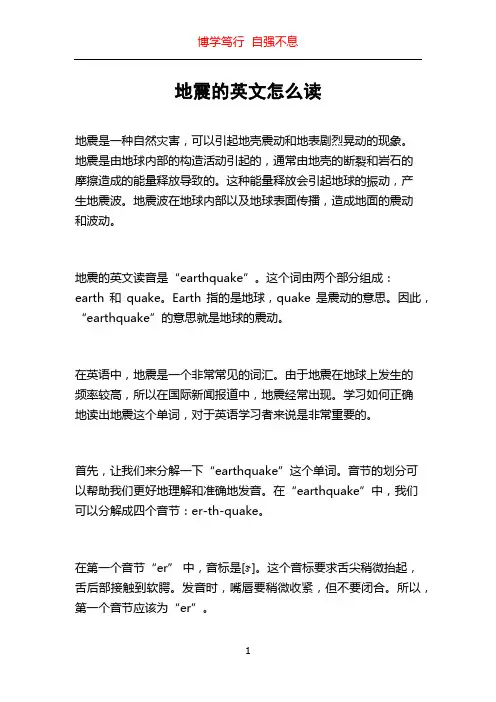
地震的英文怎么读地震是一种自然灾害,可以引起地壳震动和地表剧烈晃动的现象。
地震是由地球内部的构造活动引起的,通常由地壳的断裂和岩石的摩擦造成的能量释放导致的。
这种能量释放会引起地球的振动,产生地震波。
地震波在地球内部以及地球表面传播,造成地面的震动和波动。
地震的英文读音是“earthquake”。
这个词由两个部分组成:earth和quake。
Earth指的是地球,quake是震动的意思。
因此,“earthquake”的意思就是地球的震动。
在英语中,地震是一个非常常见的词汇。
由于地震在地球上发生的频率较高,所以在国际新闻报道中,地震经常出现。
学习如何正确地读出地震这个单词,对于英语学习者来说是非常重要的。
首先,让我们来分解一下“earthquake”这个单词。
音节的划分可以帮助我们更好地理解和准确地发音。
在“earthquake”中,我们可以分解成四个音节:er-th-quake。
在第一个音节“er” 中,音标是[ɝ]。
这个音标要求舌尖稍微抬起,舌后部接触到软腭。
发音时,嘴唇要稍微收紧,但不要闭合。
所以,第一个音节应该为“er”。
在第二个音节“th”中,音标是[θ]。
这个音标相当于中文拼音的“t”。
发音时,将舌尖紧贴着上齿龈,气流从舌间的缝隙中通过。
所以,第二个音节应该为“th”。
在第三个音节“quake”中,音标是[kweɪk]。
音标中的[k]和[w]在发音时要确保清晰。
接着是[eɪ],这个音标相当于中文拼音的“ei”。
最后一个音标是[k],与开头的[k]的发音方式相同。
因此,第三个音节应该为“-quake”。
综上所述,整个单词“earthquake”的发音按照音节划分应该为“er-th-quake”,读音为[\。

话题4 自然灾害〔Unit 4 Earthquakes〕晨读背诵根底知识自测一、单词拓展(A)根据音标及词义写出英文单词。
1. event [ɪˈvent]n. 事件;大事2. dirt [dɜːt]n. 污垢;泥土→dirty [dɜːt ɪ]adj. 脏3. burst [bɜːst]vi. 爆裂;爆发;n. 突然破裂;爆发4. ruin [ˈruːɪn]n. 废墟;消灭;vt.〔使〕破产;消灭5. injure [ˈɪndʒə(r)]vt.& vi. 损害;伤害→injured [ˈɪndʒəd]adj. 受伤→injury [ˈɪndʒərɪ]n. 伤口6. useless [ˈjuːslɪs] adj. 无用;无效;无益7. destroy [dɪˈstrɔɪ]vt.破坏;毁坏→destruction [dɪˈstrʌkʃn]n. 破坏8. electricity [ɪˏlekˈtrɪsətɪ]n. 电;电流;电学→electric [ɪˈlektrɪk]adj. 用电;带电→electrical [ɪˈlektrɪkl]adj.与电有关9. rescue [ˈreskjuː]vt.& n. 援救;营救10. disaster [dɪˈzɑːstə(r)]n.灾难;灾祸11. shock [ʃɑk]vt.& vi. 〔使〕震惊;振动n. 休克;打击;震惊12. bury [ˈberɪ]vt. 埋葬;掩埋;隐藏13. mine [maɪn]n. 矿;矿山;矿井→miner [ˈmaɪnə(r)] n. 矿工14. frighten [ˈfraɪt(ə)n] vt. 使惊吓;吓唬→frightened [ˈfraɪt(ə)nd] adj. 受惊;受恫吓→frightening [ˈfraɪtnɪŋ] adj. 令人恐惧15. judge [dʒʌdʒ] n. 裁判员;法官vt. 判定;判断;判决16. sincerely [sɪnˈsɪəlɪ]adv. 真诚地;真挚地→sincere [sɪnˈsɪə]adj. 真诚;真挚(B)单词活用用所给词正确形式填空。

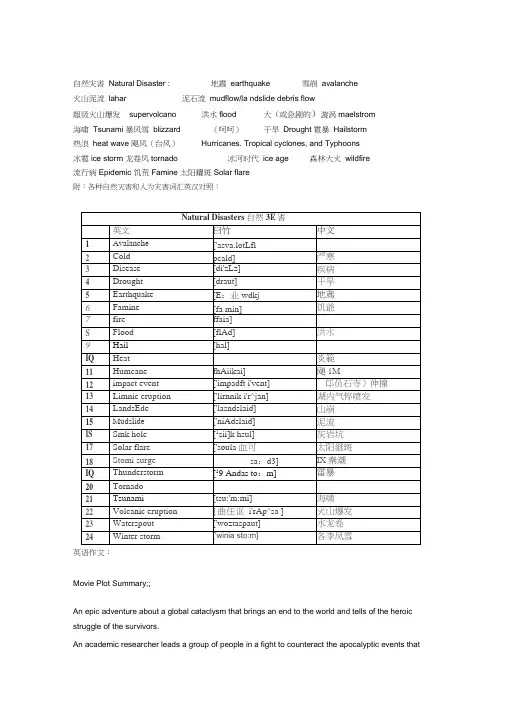
自然灾害Natural Disaster : 地震earthquake 雪崩avalanche火山泥流lahar 泥石流mudflow/la ndslide debris flow超级火山爆发supervolcano 洪水flood 大(或急剧的)漩涡maelstrom海啸Tsunami 暴风雪blizzard (呵呵)干旱Drought 雹暴Hailstorm热浪heat wave 飓风(台风)Hurricanes. Tropical cyclones, and Typhoons冰雹ice storm 龙卷风tornado 冰河时代ice age 森林大火wildfire流行病Epidemic 饥荒Famine 太阳耀斑Solar flare附:各种自然灾害和人为灾害词汇英汉对照:英语作文:Movie Plot Summary;;An epic adventure about a global cataclysm that brings an end to the world and tells of the heroic struggle of the survivors.An academic researcher leads a group of people in a fight to counteract the apocalyptic events thatwere predicted by the an cie nt Maya n cale ndar and other historical docume nts, astronomy, biblical and scientific data. It involves the passage of the Age of Pieces into the Age of Aquarius. It also in volves the Destroyer, aka Wormwood, Planet X, Nibiru. Over the decades, many have prophesised that the world will end whe n the ancient Maya n cale ndar ceases on 21 December 2012. But before that occurs, the huma n race is bound to face n atural disasters such as massive volca no erupti ons, typho ons and other n atural calamities. An academic researcher ope ns a portal into a parallel uni verse and makes con tact with his double in order to preve nt an apocalypse predicted by the ancient Maya ns.Watch on li ne Movie Trailer free 2012 Hollywood film.The film Directed by Rola nd Emmerich.The Story : 2012 movie tells the story of natural disasters foretold by ancient calendar an gle. Sun storms are affect ing Earth, cul min ati ng in tsun amis, earthquakes and volca no es. The story itself appears to be sta ndard for disaster movies - short on scie nee, long on stories of nu merous in dividuals, and high on amaz ing special effects, with a small dose of conspiracy. It ' s highly likely a pet dog survives …电影情节摘要;;一个关于全球性灾难,这带来了对世界的结束和对幸存者的可歌可泣的英勇斗争,告诉冒险。

Natural Disasters: Forces of Nature and Their Impacts自然灾害是指地球上自然界发生的具有破坏性的事件,如地震、火山喷发、飓风、洪水等。
这些突发事件往往给人类社会和生态环境带来重大影响,成为人类与自然力量间永恒的挑战。
Earthquakes: Unpredictable Shaking地震是地球内部地壳板块运动引发的一种自然现象,伴随着巨大的地表振动。
地震破坏力巨大,会导致建筑物倒塌、道路毁损、人员伤亡等严重后果。
地震预警系统和建筑抗震技术的不断发展有助于减轻地震带来的破坏。
Volcanic Eruptions: Nature’s Fury Unleashed火山喷发是地球热能的释放过程,伴随着大量的熔岩、火山灰、火山烟雾等物质喷射至地表。
火山活动的不可预测性和突发性给周边地区带来灾难性影响,包括土地破坏、空气污染、甚至人员伤亡。
Hurricanes: Power of the Storm飓风是一种热带气旋,具有强大的风力和暴雨,常常伴随着海啸、洪水等灾害。
飓风的路径和强度变化多端,给人们的防范和疏散带来极大困难,飓风过境时会带来巨大破坏力。
Floods: Unstoppable Force of Water洪水是河流、湖泊、海洋等水体泛滥而成的自然现象,往往伴随着农田被淹、房屋被毁等严重后果。
气候变化和不规范城市规划等因素增加了洪水发生的频率和破坏力,人类需要加强防洪减灾措施来减轻洪水带来的影响。
Conclusion: Resilience in the Face of Natural Disasters自然灾害无情,但人类在与自然力量的斗争中不断探索科学技术和有效应对措施,以减少灾害带来的破坏。
唯有增强社会意识、建立健全的应急机制,才能更好地保护人类生命和社会财产,展示人类对自然力量的顽强抵抗和生存智慧。
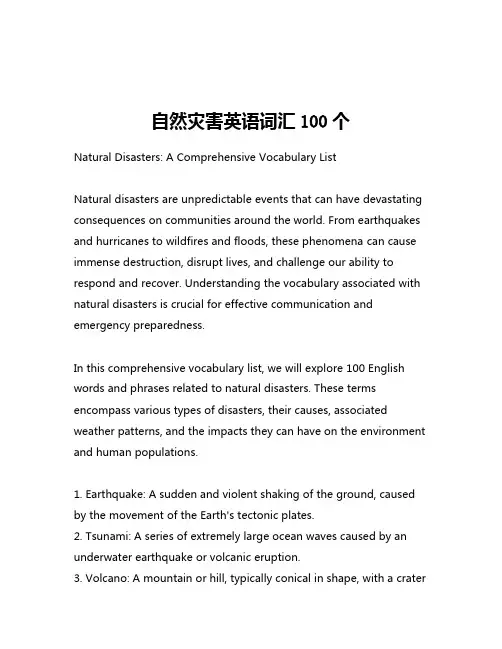
自然灾害英语词汇100个Natural Disasters: A Comprehensive Vocabulary ListNatural disasters are unpredictable events that can have devastating consequences on communities around the world. From earthquakes and hurricanes to wildfires and floods, these phenomena can cause immense destruction, disrupt lives, and challenge our ability to respond and recover. Understanding the vocabulary associated with natural disasters is crucial for effective communication and emergency preparedness.In this comprehensive vocabulary list, we will explore 100 English words and phrases related to natural disasters. These terms encompass various types of disasters, their causes, associated weather patterns, and the impacts they can have on the environment and human populations.1. Earthquake: A sudden and violent shaking of the ground, caused by the movement of the Earth's tectonic plates.2. Tsunami: A series of extremely large ocean waves caused by an underwater earthquake or volcanic eruption.3. Volcano: A mountain or hill, typically conical in shape, with a craterat the top through which lava, rock fragments, hot vapor, and gas are or have been erupted from the Earth's interior.4. Tornado: A violently rotating column of air that extends from a thunderstorm to the ground.5. Hurricane: A large, swirling storm system with high-speed winds that forms over warm ocean waters.6. Cyclone: A large-scale, swirling wind system, especially in the Indian Ocean or southwestern Pacific, that is accompanied by heavy rain.7. Typhoon: A strong tropical cyclone that occurs in the northwestern Pacific Ocean, especially in summer and autumn.8. Blizzard: A severe snowstorm with high winds and low visibility.9. Avalanche: A large mass of snow, ice, and debris sliding rapidly down a mountainside.10. Landslide: The movement of a mass of rock, debris, or earth down a slope, often triggered by heavy rain or earthquakes.11. Flood: An overflow of a large amount of water beyond its normal limits, especially over land not usually submerged.12. Drought: A prolonged period of abnormally low rainfall, leading to a shortage of water.13. Wildfire: An uncontrolled fire in a natural area, such as a forest or grassland.14. Heatwave: A prolonged period of excessively hot weather.15. Famine: A severe and widespread scarcity of food, leading to widespread hunger and starvation.16. Epidemic: A widespread occurrence of an infectious disease in a community at a particular time.17. Pandemic: A widespread outbreak of a disease that affects a large number of people across multiple countries or continents.18. Aftershock: A smaller earthquake that follows the main earthquake, often in the same area.19. Tectonic Plate: Large, rigid sections of the Earth's crust and uppermost mantle, which move and interact with one another.20. Fault Line: A fracture or crack in the Earth's crust along which the two sides have moved relative to each other.21. Epicenter: The point on the Earth's surface directly above the origin of an earthquake.22. Magnitude: A measure of the strength or size of an earthquake, based on the amount of energy released.23. Intensity: A measure of the shaking and damage caused by an earthquake at a specific location.24. Storm Surge: An abnormal rise in sea level accompanying a hurricane or other intense storm, caused by strong winds pushing water onshore.25. Storm Track: The path or trajectory of a storm system, such as a hurricane or cyclone.26. Eye of the Storm: The calm, low-pressure center of a hurricane or other powerful storm system.27. Gale: A strong wind, typically with a speed between 34 and 47 miles per hour.28. Squall: A sudden, brief increase in wind speed, often accompanied by rain, snow, or sleet.29. Monsoon: A seasonal change in the direction of the prevailing winds, especially in the Indian Ocean region, caused by differential heating of land and sea.30. Drought Index: A measure of the severity of a drought, taking into account factors such as rainfall, temperature, and soil moisture.31. Desertification: The process by which fertile land becomes desert, typically as a result of drought, deforestation, or inappropriate agriculture.32. Deforestation: The action of clearing a wide area of trees.33. Flash Flood: A sudden, violent flood that occurs in response to heavy rain, often in a localized area.34. Riverine Flood: A flood that occurs when a river overflows its banks and inundates the surrounding area.35. Coastal Flood: A flood that occurs along the coast, typically caused by a storm surge or high tide.36. Glacial Melt: The process by which glaciers and ice sheets lose mass due to rising temperatures, causing sea levels to rise.37. Permafrost: Soil that remains frozen for two or more years, found in cold regions such as the Arctic.38. Iceberg: A large piece of ice that has broken off from a glacier or ice shelf and is floating in open water.39. Wildfire Front: The leading edge of a wildfire, where the fire is actively spreading.40. Firebreak: A gap in vegetation or other combustible material that is created to stop or slow the spread of a wildfire.41. Firefighting Tactics: The strategies and techniques used by firefighters to control and extinguish wildfires.42. Evacuation Order: A directive from authorities for people to leave an area due to an imminent threat, such as a natural disaster.43. Disaster Relief: The provision of aid and assistance to people affected by a natural disaster, including food, shelter, medical care, and other essential resources.44. Humanitarian Aid: Assistance provided to people in need, such as those affected by natural disasters, wars, or other emergencies. 45. Displacement: The forced or voluntary movement of people from their homes due to a natural disaster or other crisis.46. Reconstruction: The process of rebuilding and restoring an area that has been damaged or destroyed by a natural disaster.47. Resilience: The ability of a community or ecosystem to withstand and recover from the impacts of a natural disaster.48. Mitigation: Actions taken to reduce the severity or likelihood of a natural disaster, such as building flood defenses or implementing earthquake-resistant construction.49. Adaptation: The process of adjusting to the changing environmental conditions and risks posed by natural disasters.50. Early Warning System: A system that monitors and predicts the occurrence of natural disasters, allowing for timely warnings and preparedness measures.51. Disaster Management: The coordinated efforts to prevent, prepare for, respond to, and recover from the impacts of natural disasters.52. Vulnerability: The susceptibility of a community or ecosystem to the negative effects of a natural disaster, based on factors such as location, infrastructure, and socioeconomic status.53. Risk Assessment: The process of identifying, analyzing, and evaluating the potential risks associated with a natural disaster. 54. Hazard Mapping: The creation of maps that identify and visualize the locations and severity of natural hazards, such as flood zones or earthquake fault lines.55. Disaster Response: The immediate actions taken to save lives, protect property, and provide essential services in the aftermath of a natural disaster.56. Emergency Management: The coordination of resources and responsibilities to address the consequences of natural disasters and other emergencies.57. Humanitarian Logistics: The planning, implementation, and control of the efficient and effective flow of resources and information to aid people affected by natural disasters.58. Disaster Recovery: The long-term process of rebuilding and restoring a community or ecosystem to its pre-disaster condition ora better state.59. Disaster Resilience: The ability of a community or system to withstand, adapt to, and recover from the impacts of a naturaldisaster.60. Climate Change Adaptation: The adjustment of natural or human systems to respond to the actual or expected effects of climate change, such as increased frequency and intensity of natural disasters.61. Climate Change Mitigation: Actions taken to reduce the release of greenhouse gases and other human-induced factors that contribute to climate change, which can exacerbate the occurrence and severity of natural disasters.62. Sustainable Development: The development of economic, social, and environmental systems that meet the needs of the present without compromising the ability of future generations to meet their own needs, including strategies for disaster risk reduction.63. Environmental Conservation: The protection and preservation of natural ecosystems, habitats, and resources, which can enhance resilience to natural disasters.64. Ecosystem-Based Adaptation: The use of biodiversity and ecosystem services as part of an overall adaptation strategy to help people and communities adapt to the adverse effects of climate change, including natural disasters.65. Community-Based Disaster Risk Management: A participatory approach to disaster risk management that involves local communities in the identification, analysis, and mitigation of natural disaster risks.66. Disaster Preparedness: The measures taken to ensure thatindividuals, communities, and institutions are ready to respond effectively to a natural disaster, such as emergency planning, stockpiling supplies, and conducting drills.67. Disaster Response Planning: The development of strategies and procedures to guide the immediate actions taken to save lives, protect property, and provide essential services in the aftermath of a natural disaster.68. Disaster Recovery Planning: The process of developing long-term strategies and actions to rebuild and restore a community or ecosystem following a natural disaster, with a focus on building back better and increasing resilience.69. Disaster Risk Reduction: The systematic efforts to analyze and manage the causal factors of disasters, including through reduced exposure to hazards, lessened vulnerability of people and property, wise management of land and the environment, and improved preparedness for adverse events.70. Disaster Risk Governance: The system of institutions, mechanisms, and processes through which citizens and groups articulate their interests, exercise their legal rights and obligations, and mediate their differences in the context of natural disaster risks.71. Disaster Resilient Infrastructure: The design, construction, and maintenance of buildings, transportation networks, utilities, and other critical infrastructure to withstand the impacts of natural disasters and support effective disaster response and recovery.72. Disaster Displaced Persons: People who have been forced orobliged to flee or to leave their homes or places of habitual residence as a result of a natural disaster, and who have not crossed an international border.73. Internally Displaced Persons: People or groups of people who have been forced or obliged to flee or to leave their homes or places of habitual residence, in particular as a result of or in order to avoid the effects of natural disasters, and who have not crossed an internationally recognized state border.74. Humanitarian Assistance: Aid and action designed to save lives, alleviate suffering, and maintain and protect human dignity during and in the aftermath of natural disasters and other emergencies. 75. Disaster Risk Management: The systematic process of using administrative directives, organizations, and operational skills and capacities to implement strategies, policies, and improved coping capacities to lessen the adverse impacts of natural disasters and related environmental and technological disasters.76. Vulnerability Assessment: The process of identifying, quantifying, and prioritizing the vulnerabilities of a community, system, or asset to the potential impacts of natural disasters.77. Hazard Mapping and Zoning: The process of identifying, analyzing, and visualizing the spatial distribution and characteristics of natural hazards, and using this information to guide land use planning and development decisions.78. Early Warning Systems: Coordinated systems of hazard monitoring, forecasting, and dissemination of timely warnings toenable individuals, communities, businesses, and governments to take action to reduce their risks and prepare for efficient response. 79. Disaster Risk Financing: The use of financial instruments, such as insurance, contingency funds, and risk transfer mechanisms, to manage the financial impacts of natural disasters and support effective disaster response and recovery.80. Disaster Risk Governance: The system of institutions, mechanisms, and processes through which citizens and groups articulate their interests, exercise their legal rights and obligations, and mediate their differences in the context of natural disaster risks.81. Disaster Resilience: The ability of a system, community, or society exposed to natural hazards to resist, absorb, accommodate, adapt to, transform, and recover from the effects of a hazard in a timely and efficient manner, including through the preservation and restoration of its essential basic structures and functions.82. Disaster Risk Reduction: The concept and practice of reducing disaster risks through systematic efforts to analyze and manage the causal factors of disasters, including through reduced exposure to hazards, lessened vulnerability of people and property, wise management of land and the environment, and improved preparedness for adverse events.83. Disaster Risk Management: The application of disaster risk reduction policies and strategies to prevent new disaster risks, reduce existing disaster risks, and manage residual risks, contributing to the strengthening of resilience and reduction of disaster losses.84. Disaster Recovery: The restoring or improving of livelihoods and health, as well as economic, physical, social, cultural, and environmental assets, systems, and activities, of a disaster-affected community or society, aligning with the principles of sustainable development and "build back better", to avoid or reduce future disaster risk.85. Disaster Mitigation: The lessening or minimizing of the adverse impacts of natural hazards and related environmental and technological disasters through various measures, including through improved preparedness, early warning systems, and resilient infrastructure.86. Disaster Preparedness: The knowledge and capacities developed by governments, response and recovery organizations, communities, and individuals to effectively anticipate, respond to, and recover from the impacts of likely, imminent, or current disasters.87. Disaster Response: The provision of emergency services and public assistance during or immediately after a disaster, in order to save lives, reduce health impacts, ensure public safety, and meet the basic subsistence needs of the people affected.88. Disaster Relief: The provision of assistance or intervention during or after a disaster to meet the life preservation and basic subsistence needs of those affected, including food, water, shelter, medical assistance, and other essential goods and services.89. Disaster Management: The organization, planning, and application of measures preparing for, responding to, and recoveringfrom natural disasters or other emergencies.90. Disaster Impact Assessment: The process of evaluating the severity, magnitude, and consequences of a natural disaster on the affected population, infrastructure, and environment.91. Disaster Risk Profile: A comprehensive analysis of the risks associated with natural disasters in a particular geographic area, including the identification of hazards, exposure, vulnerability, and capacity.92. Disaster Resilience Indicators: Measurable factors that reflect the ability of a community or system to withstand, adapt to, and recover from the impacts of natural disasters.93. Disaster Simulation Exercises: Controlled, scenario-based activities designed to evaluate and improve the preparedness and response capabilities of individuals, organizations, and communities to natural disasters.94. Disaster Aftercare: The provision of long-term support and assistance to individuals, families, and communities affected by natural disasters, including mental health services, livelihood recovery, and social reintegration.95. Disaster Debris Management: The coordinated effort to collect, process, and dispose of the debris and waste generated by a natural disaster, in an environmentally responsible and efficient manner. 96. Disaster Victim Identification: The process of determining the identity of individuals who have died as a result of a natural disaster, in order to provide closure and support to their families.97. Disaster Psychosocial Support: The provision of mental health and psychosocial services to individuals and communities affected by the psychological trauma and emotional distress caused by natural disasters.98. Disaster Displacement Tracking: The systematic collection and analysis of data on the movement and location of people displaced by natural disasters, to support effective humanitarian assistance and durable solutions.99. Disaster Risk Governance: The system of institutions, mechanisms, and processes through which citizens and groups articulate their interests, exercise their legal rights and obligations, and mediate their differences in the context of natural disaster risks.100. Disaster Resilience Training: The development and delivery of educational programs and workshops to build the knowledge, skills, and capacities of individuals, communities, and organizations to prepare for, respond to, and recover from natural disasters.。

自然灾害英文单词1.交通事故aground 搁浅be(go,run)aground (船)搁浅,触礁belly out 底部朝上black box (飞机等的)黑匣子bound 准备(或正在)到……去的(飞机,船等)bow 船头canyon 峡谷capsize (船等)倾覆castaway 乘船遇难者(的)cliff 悬崖collide (车船等)碰撞crash 碰撞crosswind 侧风derail 火车出轨distress signal 船只遇难时的求救信号ditch 飞机迫降在水面上,汽车开到沟里escaping hatch (潜艇的)逃生舱口ferry 渡船flip over 翻过来foul play 不正常运作fragment 碎片fuselage (飞机)机身gondola 吊舱hatch 舱门head-on train collision 火车迎面相撞heavy seas 波涛汹涌的海面hull 船壳,船体life vest 救生背心mangle 压碎,plunge 投入,跳进raft 救生筏ram 猛撞ravine 沟壑山涧深谷rescue team 援救人员rough seas 波涛汹涌的海面rudder 舵shipwreck 船只失事,失事船的残骸skip over 翻过来strand 使搁浅turbulence 湍流turbulent 狂暴的湍流的wind shear 风切变wreck on a rock 触礁失事2.地震等after shock 余震buckle 变形,坍塌calamity 灾祸debris 碎片废墟devastate 毁坏devastating quake 毁坏性地震dilapidated house 部分毁坏的房屋earthquake belt 地震带earthquake prone zone 易震带epicenter 震中eruption 喷发,爆发jolt 振摇killer earthquake (死伤人数很多的)强烈地震landslide 塌方,滑坡,山崩lava 熔岩mudslide 泥石流open-ended Richter Scale 里氏地震级quake-striken area 地震灾区reduce to rubbles 化为瓦砾rock 震动seism 地震shantytown 棚户区贫民窟shanty 棚屋shoddy building 偷工减料的建筑物skimp 克扣,偷工减料sniffer dog 警犬,嗅探器sniffer 嗅探器stench of puntrefacton 腐烂东西发出的恶臭temblor 地震tide wave 海啸tracking dog 警犬trained-dog 受过训练的狗,警犬traumatized 受过精神创伤的tremor 震颤tsunami 海啸unscrupulous 是无忌惮的不讲道理的volcano 火山3.火灾,风灾,水灾,旱灾avalanche 雪崩back-to-back storms 接踵而来的暴风雨batter (恶劣的天气)连续袭击blaze 火,熊熊燃烧blizzard 暴风雪carcase(carcass) (动物的)尸体,(蔑)人的尸体cataclysm 洪水char 烧焦choppy 风向不定的,波浪涛涛的collapse 倒坍crest 洪峰cyclone 气旋,旋风dam 水坝deluge 洪水depression 低气压dismal 凄凉的driving rain 倾盆大雨drizzle 牛毛细雨drought 干旱drown 淹死dump (雨水)倾泻embankment 堤岸embank 筑堤防护engulf 席卷吞噬flame 火焰flood-ravaged area (洪水)受灾区fume (浓烈或难闻的)烟,气,汽gale 狂风gust 阵风,(风雨雹)突然一阵gut 损毁(房屋等)内部装置hurricane 飓风inundate 水淹jetty 防波堤knee-deep (积雪等)齐膝深的,没膝的levee 大堤low-lying 地势低洼的maroon (杯水围困)处于孤立无援的境地monsoon 季风monsoon rain (印度洋)季雨pelt 连续打击,(雨雪)大降pound (连续)猛击pour 下倾盆大雨rainfall 降雨量(typhoon-)ravaged area 被(台风)破坏的地区scorch 烧焦sift 筛选详查silt 淤泥,使淤塞sleet 雨夹雪smoulder 焖烧spell (某种天气的)一段持续时间squall (冰雹)暴风stampede 惊跑乱窜stifle 使窒息submergence 浸没,淹没subside (洪水)减退suffocate 使窒息sweep (风等)刮起,浪等冲走terrified 恐惧的tornado 龙卷风torrential rain 骤雨trample 踩twister 陆海卷风,沙柱尘旋typhoon 台风uproot 连根拔wash away 冲走water-logged 涝的4. 其他用语(flood)-struck area (洪水)受灾区aid worker 救援人员make-shift 临时凑用的代用品makeshift house 临时住房philanthropic 慈善的philanthropist 慈善家philanthropoid 慈善基金会经纪人philanthropy 慈善事业puddle 水坑race against the clock 争分夺秒rage (风)狂吹,浪汹涌,病猖獗ready-made 现成的,预制的rescue worker 救援人员。
自然灾害Natural Disaster :地震earthquake 雪崩avalanche火山泥流lahar 泥石流mudflow/landslide debris flow超级火山爆发supervolcano 洪水flood 大(或急剧的)漩涡maelstrom海啸Tsunami 暴风雪blizzard (呵呵) 干旱Drought 雹暴Hailstorm热浪heat wave 飓风(台风)Hurricanes,Tropical cyclones,and Typhoons冰雹ice storm 龙卷风tornado 冰河时代ice age 森林大火wildfire流行病Epidemic 饥荒Famine 太阳耀斑Solar flare附:各种自然灾害和人为灾害词汇英汉对照:英语作文:Movie Plot Summary;;An epic adventure about a global cataclysm that brings an end to the world and tells of the heroic struggle of the survivors。
An academic researcher leads a group of people in a fight to counteract the apocalyptic events that were predicted by the ancient Mayan calendar and other historical documents, astronomy,biblical and scientific data. It involves the passage of the Age of Pieces into the Age of Aquarius. It also involves the Destroyer, aka Wormwood, Planet X, Nibiru. Over the decades,many have prophesised that the world will end when the ancient Mayan calendar ceases on 21 December 2012. But before that occurs, the human race is bound to face natural disasters such as massive volcano eruptions,typhoons and other natural calamities。
灾难英文词汇10英本3班1.交通事故aground 搁浅be(go, run)aground (船)搁浅,触礁belly out 底部朝上black box (飞机等的)黑匣子bound 准备(或正在)到……去的(飞机,船等)bow 船头canyon 峡谷capsize (船等)倾覆castaway 乘船遇难者(的)cliff 悬崖collide (车船等)碰撞crash 碰撞crosswind 侧风derail 火车出轨distress signal 船只遇难时的求救信号ditch 飞机迫降在水面上,汽车开到沟里escaping hatch (潜艇的)逃生舱口ferry 渡船flip over 翻过来foul play 不正常运作fragment 碎片fuselage (飞机)机身gondola 吊舱hatch 舱门head-on train collision 火车迎面相撞heavy seas 波涛汹涌的海面hull 船壳,船体life vest 救生背心mangle 压碎,plunge 投入,跳进raft 救生筏ram 猛撞ravine 沟壑山涧深谷rescue team 援救人员rough seas 波涛汹涌的海面rudder 舵shipwreck 船只失事,失事船的残骸skip over 翻过来strand 使搁浅turbulence 湍流turbulent 狂暴的湍流的wind shear 风切变wreck on a rock 触礁失事2.地震等sei earthquake、temblor(美)earthshock、quake、cataclysm、seism、地震epicenter、epicentre、epicentrum 、seismic vertical震中seismic belt/seismic zone/ seismic area地震带; 地震区seismic center 震中aftershock 余震Richter Scale(1—10) 里氏震级seismographer/ seismologist地震学家earthquake monitoring 地震监控seismic coefficient 地震系数dislocation earthquake断层地震folding earthquake褶皱地震local earthquake局部地震palintectic earthquake深源地震plutonic earthquake深源地震shallow-focus earthquake浅源地震simulated earthquake模拟地震submarine earthquake海底震tsunami海啸tectonic earthquake壳构地震volcanic earthquake火山地震earthquake monitoring 地震监控seismic discontinuity 地震间断面seismic regionalization 地震区划分after shock 余震magnitude 震级seismology 地震学buckle 变形,坍塌calamity 灾祸debris 碎片废墟devastate 毁坏devastating quake 毁坏性地震dilapidated house 部分毁坏的房屋earthquake belt 地震带earthquake prone zone 易震带epicenter 震中eruption 喷发,爆发jolt 振摇killer earthquake (死伤人数很多的)强烈地震landslide 塌方,滑坡,山崩lava 熔岩mudslide 泥石流open-ended Richter Scale 里氏地震级earthquake-stricken area (earthquake disaster region) 地震灾区reduce to rubbles 化为瓦砾rock 震动seism 地震shantytown 棚户区贫民窟shanty 棚屋shoddy building 偷工减料的建筑物skimp 克扣,偷工减料sniffer dog 警犬,嗅探器sniffer 嗅探器stench of putrefaction 腐烂东西发出的恶臭temblor 地震tide wave 海啸tracking dog 警犬trained-dog 受过训练的狗,警犬traumatized 受过精神创伤的tremor 震颤tsunami 海啸unscrupulous 是无忌惮的不讲道理的volcano 火山形容地震的破坏程度的动词有(按破换程度从小到大排序):damage 损害,损伤;〔口语〕伤害,毁坏destroy 毁坏,破坏;摧残shatter 破坏;捣毁;破灭devastate 蹂躏,破坏;使荒废;毁灭level 推倒,夷平flatten 夷为平地national day of mourning 全国哀悼日mourning ceremony 哀悼仪式national flags fly at half-mast 降半旗致哀silent tribute 默哀online tribute 网上悼念earthquake relief 赈灾post-disaster reconstruction 灾后重建altitude sickness 高原反应quake victims 遇难者relief work 救援工作Tibetan treatment 藏医疗法medical team 医疗队relief goods 救援物资slide-proof rug 防滑垫cold-proof coat 防寒大衣heat sensor 生命探测仪signs of life 生命迹象plague prevention 防疫plague prevention 鼠疫防疫oxygen deprivation 缺氧oxygen supply 氧源,供氧oxygen mask 氧气罩gala devoted to quake relief 赈灾晚会telethon 为募捐播放的长时间的电视节目campaign-style donation activity 大型募捐活动charity donor 慈善捐赠者donation agreement 捐赠协议charity sale 义卖giveaway buffet 慈善餐会地震知识:震源epicenter地震波seismic wave纵波P-wave横波S-wave震级magnitude里氏震级Richter scale小于2.5级的地震叫小地震,2.5-4.7级地震叫有感地震,大于4.7级地震称为破坏性地震主震main shock前震pre-earthquake余震aftershock震带earthquake zone地震烈度seismic intensity构造地震Tectonic earthquake火山地震V olcanic earthquake塌陷地震Earthquake collapse诱发地震Induced earthquake人工地震Artificial earthquake3.火灾,风灾,水灾,旱灾avalanche 雪崩back-to-back storms 接踵而来的暴风雨batter (恶劣的天气)连续袭击blaze 火,熊熊燃烧blizzard 暴风雪carcase(carcass) (动物的)尸体,(蔑)人的尸体cataclysm 洪水flood、deluge、spate洪水rock and mud slides/debris flow/ mud-rock flow 泥石流landslide 山体滑坡tornado龙卷风typhoon 台风hurricane 飓风whirlwind 龙卷风twister 龙卷风storm 暴风雨sandstorm 沙尘暴gale 狂风gust 阵风char 烧焦choppy 风向不定的,波浪涛涛的collapse 倒坍crest 洪峰cyclone 气旋,旋风dam 水坝deluge 洪水depression 低气压dismal 凄凉的driving rain 倾盆大雨drizzle 牛毛细雨drought 干旱drown 淹死dump (雨水)倾泻embankment 堤岸embank 筑堤防护engulf 席卷吞噬flame 火焰flood-ravaged area (洪水)受灾区fume (浓烈或难闻的)烟,气,汽gale 狂风gust 阵风,(风雨雹)突然一阵gut 损毁(房屋等)内部装置hurricane 飓风inundate 水淹jetty 防波堤knee-deep (积雪等)齐膝深的,没膝的levee 大堤low-lying 地势低洼的maroon (杯水围困)处于孤立无援的境地monsoon 季风monsoon rain (印度洋)季雨pelt 连续打击,(雨雪)大降pound (连续)猛击pour 下倾盆大雨rainfall 降雨量(typhoon-)ravaged area 被(台风)破坏的地区scorch 烧焦sift 筛选详查silt 淤泥,使淤塞sleet 雨夹雪smoulder 焖烧spell (某种天气的)一段持续时间squall (冰雹)暴风stampede 惊跑乱窜stifle 使窒息submergence 浸没,淹没subside (洪水)减退suffocate 使窒息sweep (风等)刮起,浪等冲走terrified 恐惧的torrential rain 骤雨trample 踩twister 陆海卷风,沙柱尘旋uproot 连根拔wash away 冲走water-logged 涝的Space disasters 空间灾害Solar flares 太阳耀斑Gamma ray burst 伽玛射线暴4. 其他用语(flood)-struck area (洪水)受灾区aid worker 救援人员make-shift 临时凑用的代用品makeshift house 临时住房philanthropic 慈善的philanthropist 慈善家philanthropoid 慈善基金会经纪人philanthropy 慈善事业puddle 水坑race against the clock 争分夺秒rage (风)狂吹,浪汹涌,病猖獗ready-made 现成的,预制的rescue worker 救援人员自然灾害学常用的100个英语单词和词组1、natural disaster 自然灾害;2、prevention of disaster 防灾;3、reduction of disaster 减灾;4、geological disaster 地质灾害;5、environment 环境;6、land 土地;7、resource 资源;8、history 历史;9、status 现状;10、water and soil 水土;11、washing away 流失;12、floodwater 洪水;13、breaking out 爆发;14、mountain coast 山体滑坡;15、vegetation 植被;16、soil fertility 土壤肥力;17、climate 气候;18、EI Nino phenomenon厄尔尼诺现象;19、marsh 湿地;沼泽;20、drought disaster旱灾;21、waterlog 涝灾;22、hail 冰雹;23、frost 霜冻;24、gale 大风;25、cold wave 寒潮;26、plant diseases and insect pests 病虫害;27、earthquake 地震;28、plague 瘟疫;29、fire disaster火灾;30、heavy snow disaster 大雪灾;31、lightning strike 雷击;32、ecology 生态;33、balance 平衡;34、original frost 初霜;35、end frost 终霜;36、spring frost 春霜;37、winter frost 冬霜;38、geological disaster 地质灾;39、heavy fog 大雾;40、animal disaster 兽害灾;41、law of drought disaster 旱灾规律;42、law of waterlog disaster 涝灾规律;43、change tendency 变化趋势;44、change law 变化规律;45、territorial disaster 区域性灾害;46、globe disaster 全球性灾害;47、environment 环境;48、protection 保护;49、surface water 地表水;50、groundwater 地下水;51、pollution 污染;52、tropic rain forest 热带雨林;53、typhoon 台风;54、cyclone 飓风;55、tornado 龙卷风;56、crypt 地穴;57、landform 地形;58、physiognomy 地貌;59、geogeny 地球成因学;60、land surface 地面;61、doing down 下沉;62、water resource 水资源;63、serious pinch 严重匮乏;64、grasshopper disaster 蝗虫灾;65、heavy drought 大旱;66、heavy waterlog 大涝;67、famine 饥荒;68、visitation of Providence 天灾;69、man-made disaster 人祸;70、surface of sea 海平面;71、moving up 上升;72、mankind 人类73、facing 面临;74、breathe 生存;75、challenge 挑战;76、volcano 火山;77、crater 火山口;78、eruption 火山灰;79、sea disaster 海洋灾害;80、storm tide 风暴潮;81、ground sea 海啸;82、red tide 赤潮;83、biologic disaster 生物灾害;84、insect pest 虫害;85、rat pest 鼠害;86、greenhouse gas 温室气体;87、greenhouse effect 温室效应;88、heavy fire from forest 森林大火;89、forestation 森林管理;90、deforestation 森林开发;91、silvics 森林生态学;92、disaster 灾害;93、measure 措施;94、strategy 策略;95、prevention and control 防治;96、countermeasure of reducing disaster 减灾对策;97、countermeasure of preventing disaster 防灾对策;98、risk analysis of natural disaster 自然灾害风险分析;99、risk assessment of natural disaster自然灾害风险评价;100、factor of leading to disaster 致灾因子。
常见自然灾害英文单词编辑整理:尊敬的读者朋友们:这里是精品文档编辑中心,本文档内容是由我和我的同事精心编辑整理后发布的,发布之前我们对文中内容进行仔细校对,但是难免会有疏漏的地方,但是任然希望(常见自然灾害英文单词)的内容能够给您的工作和学习带来便利。
同时也真诚的希望收到您的建议和反馈,这将是我们进步的源泉,前进的动力。
本文可编辑可修改,如果觉得对您有帮助请收藏以便随时查阅,最后祝您生活愉快业绩进步,以下为常见自然灾害英文单词的全部内容。
灾难英文词汇10英本3班1。
交通事故aground 搁浅be(go, run)aground (船)搁浅,触礁belly out 底部朝上black box (飞机等的)黑匣子bound 准备(或正在)到……去的(飞机,船等)bow 船头canyon 峡谷capsize (船等)倾覆castaway 乘船遇难者(的)cliff 悬崖collide (车船等)碰撞crash 碰撞crosswind 侧风derail 火车出轨distress signal 船只遇难时的求救信号ditch 飞机迫降在水面上,汽车开到沟里escaping hatch (潜艇的)逃生舱口ferry 渡船flip over 翻过来foul play 不正常运作fragment 碎片fuselage (飞机)机身gondola 吊舱hatch 舱门head-on train collision 火车迎面相撞heavy seas 波涛汹涌的海面hull 船壳,船体life vest 救生背心mangle 压碎,plunge 投入,跳进raft 救生筏ram 猛撞ravine 沟壑山涧深谷rescue team 援救人员rough seas 波涛汹涌的海面rudder 舵shipwreck 船只失事,失事船的残骸skip over 翻过来strand 使搁浅turbulence 湍流turbulent 狂暴的湍流的wind shear 风切变wreck on a rock 触礁失事2.地震等seiearthquake、temblor(美)earthshock、 quake、 cataclysm、 seism、地震epicenter、 epicentre、 epicentrum 、seismic vertical震中seismic belt/seismic zone/ seismic area地震带;地震区seismic center 震中aftershock 余震Richter Scale(1—10)里氏震级seismographer/ seismologist地震学家earthquake monitoring 地震监控seismic coefficient 地震系数dislocation earthquake断层地震folding earthquake褶皱地震local earthquake局部地震palintectic earthquake深源地震plutonic earthquake深源地震shallow-focus earthquake浅源地震simulated earthquake模拟地震submarine earthquake海底震tsunami海啸tectonic earthquake壳构地震volcanic earthquake火山地震earthquake monitoring 地震监控seismic discontinuity 地震间断面seismic regionalization 地震区划分after shock 余震magnitude 震级seismology 地震学buckle 变形,坍塌calamity 灾祸debris 碎片废墟devastate 毁坏devastating quake 毁坏性地震dilapidated house 部分毁坏的房屋earthquake belt 地震带earthquake prone zone 易震带epicenter 震中eruption 喷发,爆发jolt 振摇killer earthquake (死伤人数很多的)强烈地震landslide 塌方,滑坡,山崩lava 熔岩mudslide 泥石流open-ended Richter Scale 里氏地震级earthquake—stricken area (earthquake disaster region)地震灾区reduce to rubbles 化为瓦砾rock 震动seism 地震shantytown 棚户区贫民窟shanty 棚屋shoddy building 偷工减料的建筑物skimp 克扣,偷工减料sniffer dog 警犬,嗅探器sniffer 嗅探器stench of putrefaction 腐烂东西发出的恶臭temblor 地震tide wave 海啸tracking dog 警犬trained-dog 受过训练的狗,警犬traumatized 受过精神创伤的tremor 震颤tsunami 海啸unscrupulous 是无忌惮的不讲道理的volcano 火山形容地震的破坏程度的动词有(按破换程度从小到大排序):damage 损害,损伤;〔口语〕伤害,毁坏destroy 毁坏,破坏;摧残shatter 破坏;捣毁;破灭devastate 蹂躏,破坏;使荒废;毁灭level 推倒,夷平flatten 夷为平地national day of mourning 全国哀悼日mourning ceremony 哀悼仪式national flags fly at half-mast 降半旗致哀silent tribute 默哀online tribute 网上悼念earthquake relief 赈灾post—disaster reconstruction 灾后重建altitude sickness 高原反应quake victims 遇难者relief work 救援工作Tibetan treatment 藏医疗法medical team 医疗队relief goods 救援物资slide—proof rug 防滑垫cold—proof coat 防寒大衣heat sensor 生命探测仪signs of life 生命迹象plague prevention 防疫plague prevention 鼠疫防疫oxygen deprivation 缺氧oxygen supply 氧源,供氧oxygen mask 氧气罩gala devoted to quake relief 赈灾晚会telethon 为募捐播放的长时间的电视节目campaign—style donation activity 大型募捐活动charity donor 慈善捐赠者donation agreement 捐赠协议charity sale 义卖giveaway buffet 慈善餐会地震知识:震源epicenter地震波seismic wave纵波P—wave横波S-wave震级magnitude里氏震级 Richter scale小于2。
5级的地震叫小地震,2。
5—4。
7级地震叫有感地震,大于4.7级地震称为破坏性地震主震main shock前震 pre—earthquake余震aftershock震带earthquake zone地震烈度 seismic intensity构造地震Tectonic earthquake火山地震Volcanic earthquake塌陷地震Earthquake collapse诱发地震Induced earthquake人工地震Artificial earthquake3.火灾,风灾,水灾,旱灾avalanche 雪崩back—to-back storms 接踵而来的暴风雨batter (恶劣的天气)连续袭击blaze 火,熊熊燃烧blizzard 暴风雪carcase(carcass) (动物的)尸体,(蔑)人的尸体cataclysm 洪水flood、deluge、spate洪水rock and mud slides/debris flow/ mud—rock flow 泥石流landslide 山体滑坡tornado龙卷风typhoon 台风hurricane 飓风whirlwind 龙卷风twister 龙卷风storm 暴风雨sandstorm 沙尘暴gale 狂风gust 阵风char 烧焦choppy 风向不定的,波浪涛涛的collapse 倒坍crest 洪峰cyclone 气旋,旋风dam 水坝deluge 洪水depression 低气压dismal 凄凉的driving rain 倾盆大雨drizzle 牛毛细雨drought 干旱drown 淹死dump (雨水)倾泻embankment 堤岸embank 筑堤防护engulf 席卷吞噬flame 火焰flood—ravaged area (洪水)受灾区fume (浓烈或难闻的)烟,气,汽gale 狂风gust 阵风,(风雨雹)突然一阵gut 损毁(房屋等)内部装置hurricane 飓风inundate 水淹jetty 防波堤knee-deep (积雪等)齐膝深的,没膝的levee 大堤low-lying 地势低洼的maroon (杯水围困)处于孤立无援的境地monsoon 季风monsoon rain (印度洋)季雨pelt 连续打击,(雨雪)大降pound (连续)猛击pour 下倾盆大雨rainfall 降雨量(typhoon-)ravaged area 被(台风)破坏的地区scorch 烧焦sift 筛选详查silt 淤泥,使淤塞sleet 雨夹雪smoulder 焖烧spell (某种天气的)一段持续时间squall (冰雹)暴风stampede 惊跑乱窜stifle 使窒息submergence 浸没,淹没subside (洪水)减退suffocate 使窒息sweep (风等)刮起,浪等冲走terrified 恐惧的torrential rain 骤雨trample 踩twister 陆海卷风,沙柱尘旋uproot 连根拔wash away 冲走water-logged 涝的Space disasters 空间灾害Solar flares 太阳耀斑Gamma ray burst 伽玛射线暴4. 其他用语(flood)-struck area (洪水)受灾区aid worker 救援人员make—shift 临时凑用的代用品makeshift house 临时住房philanthropic 慈善的philanthropist 慈善家philanthropoid 慈善基金会经纪人philanthropy 慈善事业puddle 水坑race against the clock 争分夺秒rage (风)狂吹,浪汹涌,病猖獗ready-made 现成的,预制的rescue worker 救援人员自然灾害学常用的100个英语单词和词组1、natural disaster 自然灾害;2、prevention of disaster 防灾;3、reduction of disaster 减灾;4、geological disaster 地质灾害;5、environment 环境;6、land 土地;7、resource 资源;8、history 历史;9、status 现状;10、water and soil 水土;11、washing away 流失;12、floodwater 洪水;13、breaking out 爆发;14、mountain coast 山体滑坡;15、vegetation 植被;16、soil fertility 土壤肥力;17、climate 气候;18、EI Nino phenomenon厄尔尼诺现象;19、marsh 湿地;沼泽;20、drought disaster旱灾;21、waterlog 涝灾;22、hail 冰雹;23、frost 霜冻;24、gale 大风;25、cold wave 寒潮;26、plant diseases and insect pests 病虫害;27、earthquake 地震;28、plague 瘟疫;29、fire disaster火灾;30、heavy snow disaster 大雪灾;31、lightning strike 雷击;32、ecology 生态;33、balance 平衡;34、original frost 初霜;35、end frost 终霜;36、spring frost 春霜;37、winter frost 冬霜;38、geological disaster 地质灾;39、heavy fog 大雾;40、animal disaster 兽害灾;41、law of drought disaster 旱灾规律;42、 law of waterlog disaster 涝灾规律;43、change tendency 变化趋势;44、change law 变化规律;45、territorial disaster 区域性灾害;46、globe disaster 全球性灾害;47、environment 环境;48、protection 保护;49、surface water 地表水;50、groundwater 地下水;51、pollution 污染;52、tropic rain forest 热带雨林;53、typhoon 台风;54、cyclone 飓风;55、tornado 龙卷风;56、crypt 地穴;57、landform 地形;58、physiognomy 地貌;59、geogeny 地球成因学;60、land surface 地面;61、doing down 下沉;62、water resource 水资源;63、serious pinch 严重匮乏;64、grasshopper disaster 蝗虫灾;65、heavy drought 大旱;66、heavy waterlog 大涝;67、famine 饥荒;68、visitation of Providence 天灾;69、man-made disaster 人祸;70、surface of sea 海平面;71、moving up 上升;72、mankind 人类73、facing 面临;74、breathe 生存;75、challenge 挑战;76、volcano 火山;77、crater 火山口;78、eruption 火山灰;79、sea disaster 海洋灾害;80、storm tide 风暴潮;81、ground sea 海啸;82、red tide 赤潮;83、biologic disaster 生物灾害;84、insect pest 虫害;85、rat pest 鼠害;86、greenhouse gas 温室气体;87、greenhouse effect 温室效应;88、heavy fire from forest 森林大火;89、forestation 森林管理;90、deforestation 森林开发;91、silvics 森林生态学;92、disaster 灾害;93、measure 措施;94、strategy 策略;95、prevention and control 防治;96、countermeasure of reducing disaster 减灾对策;97、countermeasure of preventing disaster 防灾对策;98、risk analysis of natural disaster 自然灾害风险分析;99、risk assessment of natural disaster自然灾害风险评价;常见自然灾害英文单词100、factor of leading to disaster 致灾因子。